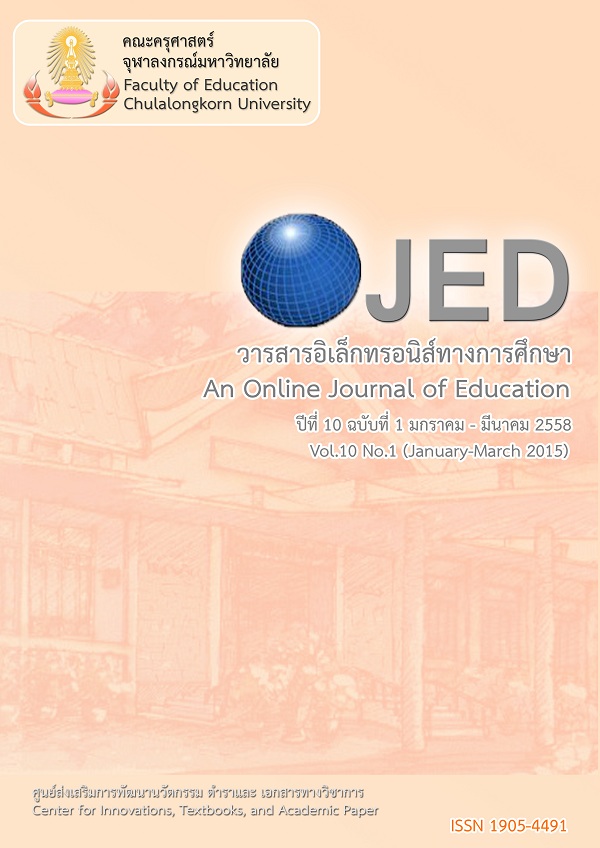กลวิธีการสร้างแรงจูงใจสำหรับห้องเรียนภาษาอังกฤษในประเทศไทย: มุมมองของครูผู้สอนภาษาอังกฤษ
Keywords:
แรงจูงใจ/ กลยุทธ์สร้างแรงจูงใจ/ ครูวิชาภาษาอังกฤษ/ MOTIVATION/ MOTIVATIONAL STRATEGIES/ ENGLISH LANGUAGE TEACHERSAbstract
ด้วยเหตุว่าแรงจูงใจได้รับการยอมรับให้เป็นหนึ่งในปัจจัยสำคัญต่อการเรียนรู้ภาษาที่สอง/ต่างประเทศ วิธีการที่ครูสร้างแรงจูงใจให้นักเรียนถูกยกขึ้นเป็นปัญหาสำคัญอีกปัญหาหนึ่งในสาขาการเรียนรู้ภาษา (Sugita & Takeuchi, 2009) งานวิจัยหลายชิ้นค้นพบว่าการใช้กลยุทธ์การสร้างแรงจูงใจสามารถเป็นเรื่องอคติทางวัฒนธรรม (Dörney & Csizér, 1998) งานวิจัยชิ้นนี้นำวิธีการของ Cheng และ Dörney (2007) มาใช้โดยมีจุดมุ่งหมายที่จะระบุมุมมองของครูสอนวิชาภาษาอังกฤษชาวไทยเรื่องความสำคัญและการใช้กลยุทธ์การสร้างแรงจูงใจ 48 วิธี นอกเหนือจากนี้ งานวิจัยชิ้นนี้ต้องการสำรวจความสัมพันธ์ระหว่างกลยุทธ์การสร้างแรงจูงใจที่สำคัญและกลยุทธ์ที่ได้รับการใช้บ่อยครั้ง ครูสอนวิชาภาษาอังกฤษในโรงเรียนในสังกัดการศึกษาขั้นพื้นฐานในประเทศไทยจำนวน 74 คนได้ตอบแบบสอบถามสองชุดที่มีจำนวน 48 ข้อเหมือนกัน โดยคัดเลือกด้วยวิธีการเลือกกลุ่มตัวอย่างที่ได้จากการกล่าวอ้างถึง (snowball sampling) ผลการวิจัยแสดงให้เห็นว่ากลยุทธ์การสร้างแรงจูงใจที่ผู้เข้าร่วมงานวิจัยเห็นว่าสำคัญที่สุด คือ “พฤติกรรมของครูที่ถูกต้องตามกาลเทศะ” ซึ่งมีความสอดคล้องกับผลการวิจัยที่คล้ายคลึงกันในประเทศฮังการีและประเทศไต้หวัน ผลงานวิจัยอีกจุดที่น่าสนใจ คือ “การนำเสนอภาระหน้าที่อย่างเหมาะสม” ที่ถูกมองว่าเป็นกลยุทธ์การสร้างแรงจูงใจที่มีความสำคัญน้อยที่สุด ได้รับการรายงานว่าเป็นกลยุทธ์การสร้างแรงจูงใจที่ผู้เข้าร่วมงานวิจัยใช้บ่อยครั้งที่สุด ผลการวิจัยข้อนี้เผยความไม่สอดคล้องกันระหว่างกลยุทธ์การสร้างแรงจูงใจที่ถูกมองว่ามีความสำคัญและกลยุทธ์ที่ได้รับการใช้จริง นอกจากนี้ งานวิจัยยังค้นพบว่าหลักสูตรแกนกลางจำกัดการใช้กลยุทธ์การสร้างแรงจูงใจบางกลยุทธ์โดยครูวิชาภาษาอังกฤษชาวไทยอีกด้วย
With motivation being recognised as one of the key factors in second/foreign language learning, how teachers motivate students has been raised as an important issue in the language learning field (Sugita & Takeuchi, 2009). Studies have revealed that the use of motivational strategies can be culturally biased (Dörney & Csizér, 1998). Adopting the approach from Cheng and Dörney’s (2007), this research aimed to identify Thai teachers of English’s perspectives on the importance and their use of 48 motivational strategies. In addition, relationships between the reported important motivational strategies and the frequently used strategies were investigated. Two sets of questionnaires with the same 48 items were distributed to 74 English teachers in basic education schools in Thailand using snow-ball sampling strategy. The results showed that the most important motivational strategy as percieved by the participants was ‘proper teacher behavior,’ which is consistent with the results of similar studies in Hungary and Taiwan. Interestingly, ‘present tasks properly,’ which was perceived as the least important motivational strategy, was reported to be used the most frequently among the participants. This finding reveals a mismatch between the perceived important motivatonal strategy and the actual used one. Also, Thai English teachers have been found to be constrained to apply certain motivational strategies by the Basic Education Core Curriculum.




